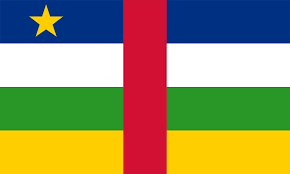Meaning of Colors of Central African Republic Flag
What is the Meaning of the Colors of the Central African Republic Flag?
In the realm of national symbolism, flags serve as powerful visual representations of a country's identity, history, and aspirations. The flag of the Central African Republic (CAR) stands proudly among the array of flags that adorn the world's nations. Its design, though seemingly simple, carries profound significance, with each color carefully chosen to reflect the nation's heritage, values, and aspirations.
Understanding the Flag
Before delving into the meanings behind the colors of the Central African Republic flag, it's essential to grasp its overall design. The flag consists of four horizontal stripes of equal width, with colors alternating between blue, white, green, and yellow, from top to bottom.
Meaning of Colors
Blue Stripe
Starting from the top, the blue stripe represents the sky that blankets the Central African Republic. It serves as a reminder of the vastness of the nation's skies, under which its people live and thrive. Additionally, blue is often associated with peace, stability, and harmony, qualities that the country aspires to achieve and maintain amidst its historical and contemporary challenges.
White Stripe
Following the blue stripe, the white stripe signifies purity and peace. White is universally recognized as a color of peace, unity, and neutrality. In the context of the Central African Republic, the white stripe serves as a beacon of hope for a nation that has faced tumultuous periods of conflict and strife. It symbolizes the country's desire for reconciliation, unity, and the pursuit of peace among its diverse population.
Green Stripe
The green stripe occupies the third position on the flag and represents the lush vegetation and fertile lands of the Central African Republic. Green is often associated with growth, prosperity, and vitality, reflecting the country's agricultural richness and natural resources. Moreover, green symbolizes hope and renewal, signifying the nation's resilience and determination to overcome challenges and build a prosperous future for its citizens.
Yellow Stripe
Finally, the yellow stripe at the bottom of the flag symbolizes the abundant sunshine that bathes the Central African Republic. Yellow is a color often associated with warmth, energy, and optimism. It represents the bright prospects and potential of the nation, as well as the resilience and strength of its people in the face of adversity.
Historical and Cultural Context
To truly appreciate the symbolism behind the colors of the Central African Republic flag, it's essential to consider the historical and cultural context in which the flag was adopted. The flag was officially adopted on December 1, 1958, shortly before the country gained independence from French colonial rule on August 13, 1960
During the colonial era, the Central African Republic, like many other African nations, experienced the imposition of foreign rule and the suppression of its indigenous cultures and identities. The adoption of the national flag symbolized a newfound sense of sovereignty and self-determination for the people of the Central African Republic. It represented their aspirations for freedom, unity, and progress as they embarked on a journey towards nation-building and independence.
Furthermore, the colors chosen for the flag reflected the natural beauty and resources of the Central African Republic, as well as the values and aspirations of its people. Blue, white, green, and yellow were selected not only for their aesthetic appeal but also for their deep symbolic significance in the cultural and natural landscape of the country.
Contemporary Significance
In contemporary times, the colors of the Central African Republic flag continue to hold significant meaning for the nation and its people. Despite facing numerous challenges, including political instability, ethnic tensions, and economic hardships, the flag serves as a unifying symbol that transcends divisions and promotes a sense of national pride and identity.
The blue, white, green, and yellow stripes remind the citizens of the Central African Republic of their shared heritage, values, and aspirations. They serve as a reminder of the country's rich natural resources, cultural diversity, and resilience in the face of adversity. Moreover, the flag embodies the collective aspirations of the Central African people for peace, stability, and prosperity for future generations.
Conclusion
In conclusion, the colors of the Central African Republic flag represent more than just mere aesthetics; they embody the nation's identity, history, and aspirations. From the azure skies to the golden sunshine, each color carries profound symbolism that reflects the natural beauty, cultural richness, and resilience of the Central African Republic and its people.
As the nation continues to navigate its path toward peace, development, and prosperity, the flag serves as a powerful reminder of the values and aspirations that unite its citizens. It stands as a testament to the enduring spirit of the Central African people and their unwavering commitment to building a brighter future for themselves and generations to come.
